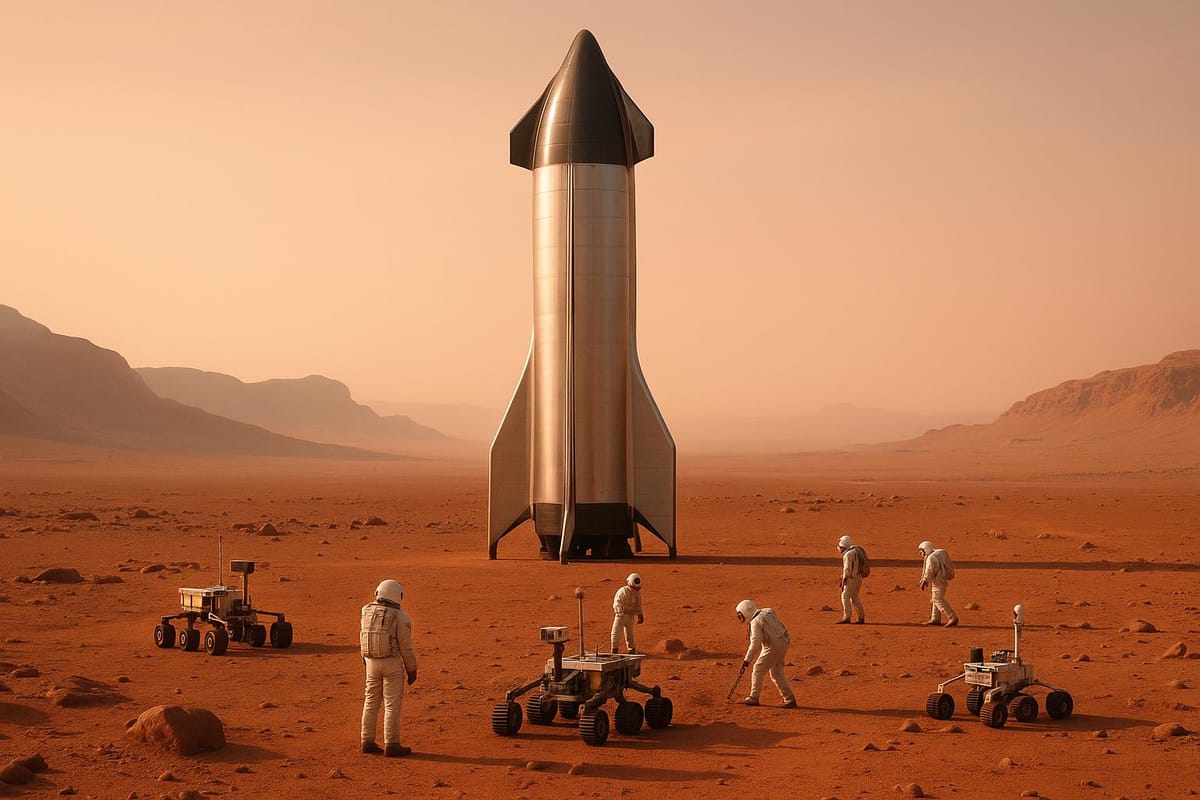Starship's Role in Mars Surface Operations
Explore how various vehicles, including a groundbreaking spacecraft, are set to transform Mars exploration and support human settlement on the Red Planet.

SpaceX's Starship offers a groundbreaking shift in Mars exploration. Its ability to carry up to 100 metric tons of cargo per mission and refuel on Mars makes it a standout option for building infrastructure and enabling human settlement on the Red Planet. But how does it compare to NASA's Mars Ascent Vehicle (MAV) and the conceptual Starboat design? Here's a quick breakdown:
- Starship: High payload (100 metric tons), reusable, supports crew and cargo, costs ~$100M per mission.
- MAV: Small payload (500g), single-use, focuses on sample return, costs billions per mission.
- Starboat: Medium payload (20-50 metric tons), partially reusable, designed for surface mobility, still in concept.
Each system serves a unique purpose. Starship excels in large-scale deployments, MAV specializes in reliable sample returns, and Starboat could fill niche roles focused on surface transport. Together, they represent complementary approaches for achieving long-term Mars exploration goals.
Quick Comparison:
| Feature | Starship | MAV | Starboat |
|---|---|---|---|
| Payload Capacity | Up to 100 tons | ~500g | 20-50 tons |
| Reusability | Fully reusable | Single-use | Partially reusable |
| Crew Capability | Crewed & cargo | None (sample return) | Surface crew only |
| Mission Cost | ~$100M | Billions | Unknown |
| Surface Mobility | Stationary | Stationary | Limited movement |
Starship's cost-efficiency and multi-use design could transform Mars missions, while MAV and Starboat address more specific needs. Together, these vehicles may pave the way for sustainable Mars operations.
1. SpaceX Starship

Payload Capacity
The SpaceX Starship is engineered to deliver up to 100 metric tons (about 220,462 pounds) of payload to the Martian surface in a single flight. To put that into perspective, NASA's Perseverance rover carried just around 1 metric ton to Mars. This massive payload capacity means Starship can transport multiple rovers, habitat modules, and even construction equipment in one trip. It’s equipped with large payload deployment doors, approximately 3 meters by 3 meters (roughly 10 feet by 10 feet), allowing for the autonomous unloading of heavy equipment. Combined with its reusability, this capability makes Starship a game-changer for interplanetary missions.
Reusability Features
Starship is designed for full reusability, featuring a heat shield made with hexagonal metallic-ceramic tiles capable of withstanding repeated atmospheric entries. During descent, it performs a unique "belly-flop" maneuver, using four flaps to guide its descent before flipping upright for a vertical landing powered by its engines. Standing at 52 meters (171 feet) tall, it’s the tallest spacecraft ever designed for landing on Mars. While this height provides exceptional payload space, it also introduces stability challenges that engineers have worked to address. Notably, the first Starship vehicles sent to Mars are planned to remain there permanently, serving as part of the infrastructure for future missions.
Surface Mobility Support
Starship's design also simplifies operations on the Martian surface. Its spacious payload bay can carry multiple mobile platforms and vehicles, such as rovers and rotorcraft, in both the forward and aft cargo areas. This setup allows for direct deployment, enabling simultaneous operations and broader surface exploration. The payload bay also provides direct access to the Martian surface, streamlining the deployment of equipment and allowing crews to exit the spacecraft more efficiently.
Crew Return Capability
One of Starship's standout features is its ability to bring the crew back to Earth. It achieves this by refueling on Mars, using local resources to produce methane and oxygen propellants through a process called in-situ resource utilization (ISRU). Early uncrewed missions will focus on setting up the necessary ISRU infrastructure and scouting for resources. Once refueled, Starship can take off directly from Mars, carrying both crew and cargo back to Earth. This round-trip capability is a game-changer for Mars exploration, paving the way for sustainable crew rotations and the regular return of materials, which are critical for establishing a long-term human presence on the Red Planet.
2. NASA Mars Ascent Vehicle

Payload Capacity
The NASA Mars Ascent Vehicle (MAV) is built with one specific mission in mind: bringing samples back from Mars. It’s designed to carry about 500 grams (approximately 1.1 pounds) of Martian material to orbit. The vehicle itself is relatively compact, measuring 2.8 meters (9.2 feet) in length and 0.57 meters (1.9 feet) in diameter. Despite its small size, it weighs around 400 kilograms (880 pounds) - a stark contrast to the massive 100-metric-ton capacity of SpaceX's Starship. Tailored exclusively for NASA's Mars Sample Return mission, the MAV is set to make history as the first rocket to launch from another planet.
Surface Mobility Support
Unlike the highly adaptable Starship, the MAV is a stationary vehicle. It’s designed to launch from a fixed platform delivered to Mars by a lander. While Starship can deploy cargo and move independently, the MAV focuses solely on one task: ascending to orbit with collected samples. It relies entirely on rovers to gather and deliver those samples to its platform. This specialized design ensures a clear division of responsibilities - rovers handle surface exploration, while the MAV takes on the critical job of transporting the samples into orbit.
Crew Return Capability
The MAV is uncrewed and laser-focused on its ascent mission. To complete its task, it needs to reach speeds of about 4 km/s (approximately 8,950 mph), allowing it to deliver its sample container into Mars orbit. Once in orbit, the container will be captured by a waiting spacecraft for its journey back to Earth. While the current design is solely for sample return, there are concepts for a crewed version in the future. These ideas include adding life support systems, increasing payload capacity, and using in-situ resource utilization (ISRU) to produce propellant on Mars. For now, the MAV’s design emphasizes reliability and efficiency, ensuring it can withstand the harsh Martian environment, including extreme temperature fluctuations and extended periods on the surface.
The Trillion Dollar Starship - Get to Mars Part 1
3. Starboat Concept Design
The Starboat concept introduces a fresh perspective for Mars exploration, prioritizing mobility and modular functionality over sheer cargo capacity.
Payload Capacity
Designed for surface operations on Mars, the Starboat takes advantage of the substantial cargo capacity offered by next-generation landers like Starship. It is proposed to carry between 20 and 50 metric tons - less than Starship's 100-metric-ton capacity. This reduction is intentional, trading off raw payload size to focus on specialized tasks. The Starboat's primary goal is to efficiently transport and reposition critical assets across the Martian surface, ensuring resources are deployed where they’re most needed.
Reusability Features
Unlike the fully reusable Starship, which is designed for Earth-to-Mars missions, the Starboat focuses on partial reusability for operations confined to the Martian surface. It would rely on Mars-refueled propellant to perform multiple surface hops, extending its operational lifespan. Key design features include sturdy landing gear, components resistant to Martian dust, and modular parts that can be serviced or replaced on-site. This approach ensures the Starboat can handle repeated use without requiring a return to Earth, making it a practical tool for sustained exploration.
Surface Mobility Support
One of the standout features of the Starboat is its emphasis on mobility. Equipped with propulsion systems, it could "hop" between locations, covering terrain that traditional rovers cannot navigate. This capability would allow for broader scientific exploration and greater redundancy, as multiple vehicles could be deployed simultaneously. Even if one vehicle faces an issue, others could continue operations. Experts like Robert Zubrin and NASA mission planners have emphasized the importance of such mobility in creating a lasting human presence on Mars.
Crew Return Capability
While the Starboat is not designed for direct Earth return, it offers limited crew return capability to Mars orbit. This means it can transport crew members to orbit, where they would rendezvous with a dedicated return craft. By focusing solely on Mars-orbit ascent, the Starboat avoids the added complexity and mass required for interplanetary travel. This design keeps the vehicle streamlined and better suited for surface operations, while still ensuring crew safety. However, this strategy does depend on additional orbital infrastructure to complete the return journey.
Advantages and Disadvantages
When it comes to sustainable Mars operations, every vehicle design comes with its own set of trade-offs. These trade-offs play a crucial role in determining which vehicle is best suited for specific mission needs.
SpaceX Starship stands out for its sheer capability and affordability. With an impressive payload capacity, it can deliver volumes that traditional methods simply can't match. In fact, tasks that might take decades with other approaches could potentially be completed in a single Starship mission. Its fully reusable design is projected to lower costs to around $100 million per mission. On top of that, Starship's ability to deploy multiple assets simultaneously adds a layer of redundancy to operations.
But Starship isn't without its challenges. Its towering 52-meter height creates a higher center of gravity, which increases the risk of tipping on Mars' uneven terrain. The heat shield, designed to handle repeated entries, presents unique maintenance demands. Additionally, its reliance on multiple orbital refueling launches introduces logistical complexities that could delay or even jeopardize missions.
On the other hand, NASA's Mars Ascent Vehicle (MAV) is designed with reliability in mind. Its compact, stable design minimizes technical risks, making it a trusted choice for specialized tasks. However, its limited payload capacity confines it to roles like sample return missions. Moreover, the fact that each MAV is single-use and must be newly built for every mission drives costs into the billions of dollars.
Then there's the Starboat concept, which focuses on operational flexibility rather than raw capacity. With a modest payload and the ability to reposition on the Martian surface, it’s tailored for specific, smaller-scale tasks. However, as a conceptual design, Starboat lacks the extensive testing of Starship or the proven track record of the MAV. Its reliance on orbital infrastructure for crew return further complicates its use.
| Feature | SpaceX Starship | NASA Mars Ascent Vehicle | Starboat Concept |
|---|---|---|---|
| Payload Capacity | Up to 100 metric tons | Less than 500 kg | Typically <1 metric ton |
| Reusability | Fully reusable | Single-use | Partially reusable |
| Landing Stability | High tipping risk | Very stable | Moderate |
| Mission Cost | ~$100 million | Billions per mission | Unknown |
| Crew Capability | Crewed & cargo | Sample return only | None |
| Surface Mobility | Stationary after landing | Stationary | Limited repositioning |
| Infrastructure Support | Extensive deployment | Minimal | Limited |
| Development Status | Under active testing | Flight-proven concepts | Conceptual design |
Starship’s high payload capacity and reusability make it a game-changer for reducing mission costs, especially compared to the single-use MAV. Meanwhile, the Starboat concept offers potential for niche applications with its emphasis on flexibility.
No single design can meet all the demands of Mars surface operations. Starship excels at large-scale infrastructure deployment, while MAV’s reliability is indispensable for mission-critical tasks. Concepts like Starboat could eventually fill specific operational gaps. A combined strategy - leveraging Starship's scale, MAV's reliability, and Starboat's adaptability - may hold the key to long-term success on Mars.
The increasing focus on Mars exploration has also attracted significant private investment. For example, resources like the SpaceX Stock Investment Guide highlight the commercial potential that continues to drive innovation in Mars vehicle development.
Conclusion
The analysis above highlights how Starship could reshape Mars exploration. With the ability to transport up to 100 metric tons of cargo to the Red Planet, it opens doors to faster progress in building critical infrastructure compared to traditional methods. That said, achieving these advancements comes with its own set of technical challenges.
Starship’s reusable design and estimated ~$100 million mission cost significantly lower expenses while enabling the deployment of multiple assets simultaneously. This cost-efficiency makes it possible to establish redundant systems and speed up the development of essential facilities.
However, its towering 52-meter height and vertical landing system introduce stability concerns on Mars' uneven terrain. Additionally, ensuring the durability of its reusable heat shield remains a key engineering hurdle. Addressing these challenges will require thorough site analysis and the creation of reliable automated systems before moving forward with crewed missions.
The vehicle’s reliance on in-situ resource utilization (ISRU) for refueling and its scalable deployment strategy are central to plans for a sustained Martian presence. By doubling the number of vehicles launched during each 26-month window, SpaceX can steadily expand operations, laying the groundwork for a permanent human settlement.
On the commercial side, these innovations are drawing significant private investment interest. Beyond just transportation, Starship represents a shift toward reusable, high-capacity systems that could make Mars colonization financially feasible. Its ability to establish infrastructure quickly positions it as a key player in humanity’s journey toward becoming a multi-planetary species.
For those looking to dive deeper into SpaceX’s groundbreaking strategies and the evolving space economy, check out the SpaceX Stock Investment Guide for insights on the company’s valuation, news, and investment opportunities.
FAQs
How does Starship's refueling capability on Mars support long-term exploration and sustainability?
SpaceX's Starship has an ingenious feature: it can refuel on Mars using the planet's own resources. By tapping into carbon dioxide from the Martian atmosphere and water ice, Starship produces methane and liquid oxygen through a process called the Sabatier reaction. This means the spacecraft can generate its own fuel, making it possible to return to Earth or venture further into the solar system without relying on fuel brought from Earth.
This method, known as in-situ resource utilization (ISRU), cuts down the need to haul massive amounts of fuel from Earth. Not only does this make missions to Mars more affordable, but it also lays the groundwork for creating a self-sustaining presence on the planet. With this capability, Starship opens the door to extended human settlement and groundbreaking scientific exploration on Mars.
What challenges might SpaceX's Starship face when landing vertically on Mars' uneven terrain, and how could these be addressed?
Landing a spacecraft vertically on Mars is no easy feat. The planet's rugged terrain, weaker gravity - only about 38% of Earth's - and its thin atmosphere, which limits aerodynamic braking, all add to the complexity. SpaceX's Starship will need to depend heavily on its cutting-edge Raptor engines to maintain precise control during its descent and landing.
To tackle these hurdles, Starship's landing legs are built to handle the impact and keep the spacecraft steady, even on uneven ground. On top of that, advanced navigation systems and terrain-relative mapping will play a crucial role in pinpointing safe landing spots in real time. These technologies work together to reduce the risk of instability and pave the way for secure landings on Mars in future missions.
How could the Starboat concept enhance Starship and MAV's roles in Mars surface operations?
At the moment, there’s no public information available about the Starboat concept or how it might fit into Mars surface operations alongside SpaceX’s Starship and the Mars Ascent Vehicle (MAV). SpaceX is known for pushing boundaries, so it’s possible that new ideas will surface to enhance Mars exploration and settlement efforts. For now, the spotlight is on Starship’s flexible design, which plays a key role in transporting crew, cargo, and equipment to Mars and back to Earth.
Comments ()